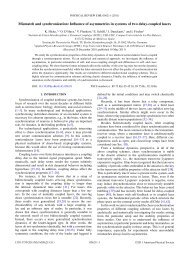DBI Analysis of Open String Bound States on Non-compact D-branes
DBI Analysis of Open String Bound States on Non-compact D-branes
DBI Analysis of Open String Bound States on Non-compact D-branes
Create successful ePaper yourself
Turn your PDF publications into a flip-book with our unique Google optimized e-Paper software.
CHAPTER 3. SUPERSTRINGS 46freedom to our theory does not suffice to get rid <str<strong>on</strong>g>of</str<strong>on</strong>g> it. We will need to be more clever ifwe want to beat it. Remark that this ground state is unique, hence describes a spin 0state, hence is bos<strong>on</strong>ic.We can c<strong>on</strong>struct a first excited state by acting <strong>on</strong>ce with a b raising operator.Remember that the b’s are half-integer moded, and thus b i is lower in energy than− 1 2α−1 i . Thus, we identify the first excited state asb i |0〉− 1 NS . (3.39)2We have eight sets <str<strong>on</strong>g>of</str<strong>on</strong>g> transverse oscillators, and thus also eight b i operators. So we find− 1 2ourselves with a state that transforms under SO(8), and hence is a space-time vectorbos<strong>on</strong>. This should be a massless state (recall the similar discussi<strong>on</strong> in Chapter 2). Asec<strong>on</strong>d look at Eq. 3.37 learns us that acting with α−n i increases the mass with m, 4while acting with b i −r increases the mass with r. Since our groundstate has mass − 1 2 ,and r = 1 2for our first excited state, we indeed verify that this is true. (Not knowing thevalue <str<strong>on</strong>g>of</str<strong>on</strong>g> a NS , and applying the inverse reas<strong>on</strong>ing is again a way to see that a NS shouldbe 1 2.) This is good because we find back our beloved phot<strong>on</strong>.The sec<strong>on</strong>d excited state can be obtained either by applying <strong>on</strong>ce an α raising operator,or by applying two b raising operators. Beware though, the b’s satisfy anticommutati<strong>on</strong>relati<strong>on</strong>s, and so we can not excite twice in the same directi<strong>on</strong> with thesame operator, as ( b i 2r)= 0. This greatly diminishes the number <str<strong>on</strong>g>of</str<strong>on</strong>g> b raising operatorcombinati<strong>on</strong>s we can form. In this particular case, we can choose <strong>on</strong>e out <str<strong>on</strong>g>of</str<strong>on</strong>g> eight b i − 1 2operators for the first operator, and <strong>on</strong>e <str<strong>on</strong>g>of</str<strong>on</strong>g> the seven remaining b j for the sec<strong>on</strong>d <strong>on</strong>e.− 1 2Also keeping in mind that b i b j = −b j b i , further diminishing the number <str<strong>on</strong>g>of</str<strong>on</strong>g> possibilitieswith a factor two. We are left with (8 ×7)/2 = 28 distinct possible states. Add− 1 2 − 1 − 1 − 1 2 2 2to these the eight states we obtain by applying an α− i operator, and we obtain 36 statesin total for the sec<strong>on</strong>d excited state with mass α ′ M 2 = 1 2 .Generalizing this to the rest <str<strong>on</strong>g>of</str<strong>on</strong>g> the spectrum, we find that we can encode the number<str<strong>on</strong>g>of</str<strong>on</strong>g> states at every mass level using the generating functi<strong>on</strong>f ′ NS (x) =+∞ ∏n=1(1 + x n−1 21 − x n ) 8. (3.40)We recognize the denominator as encoding states resulting from acting with bos<strong>on</strong>icmodes. The numerator encodes the states resulting from acting with fermi<strong>on</strong>ic modes.( 8Indeed, 1 + x 2) n−1 is in fact nothing but a polynomial <str<strong>on</strong>g>of</str<strong>on</strong>g> which the coefficients willequal ( 8m), with m ∈ {1, . . .,8}, corresp<strong>on</strong>ding exactly to all possible ways <str<strong>on</strong>g>of</str<strong>on</strong>g> combiningeight anticommuting b operators with mode number n − 1 2 . Defining4 See Eq. 3.29.f NS (x) = 1 √ xf ′ NS (x) = 1 √ x +∞ ∏n=1(1 + x n−1 21 − x n ) 8, (3.41)
















